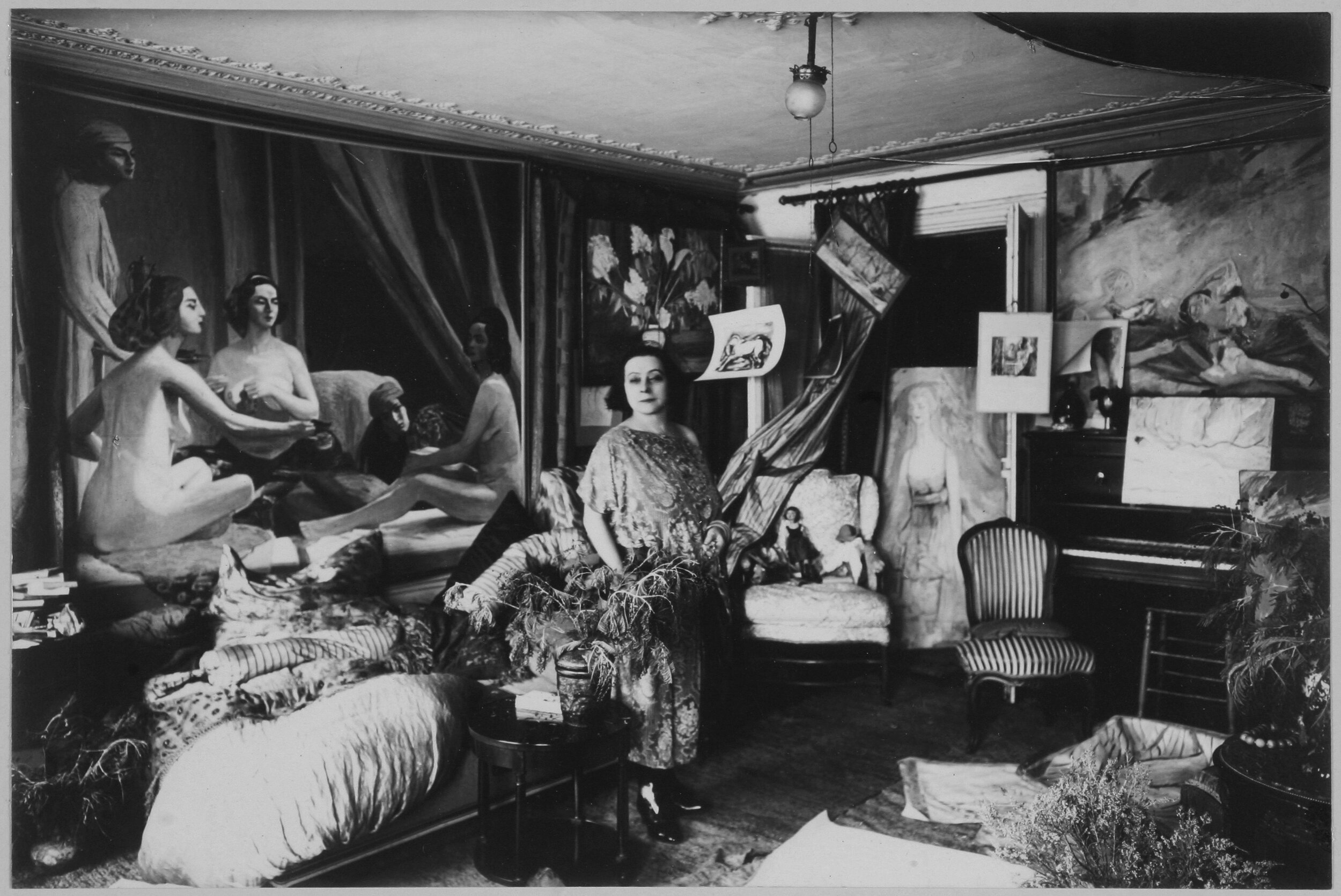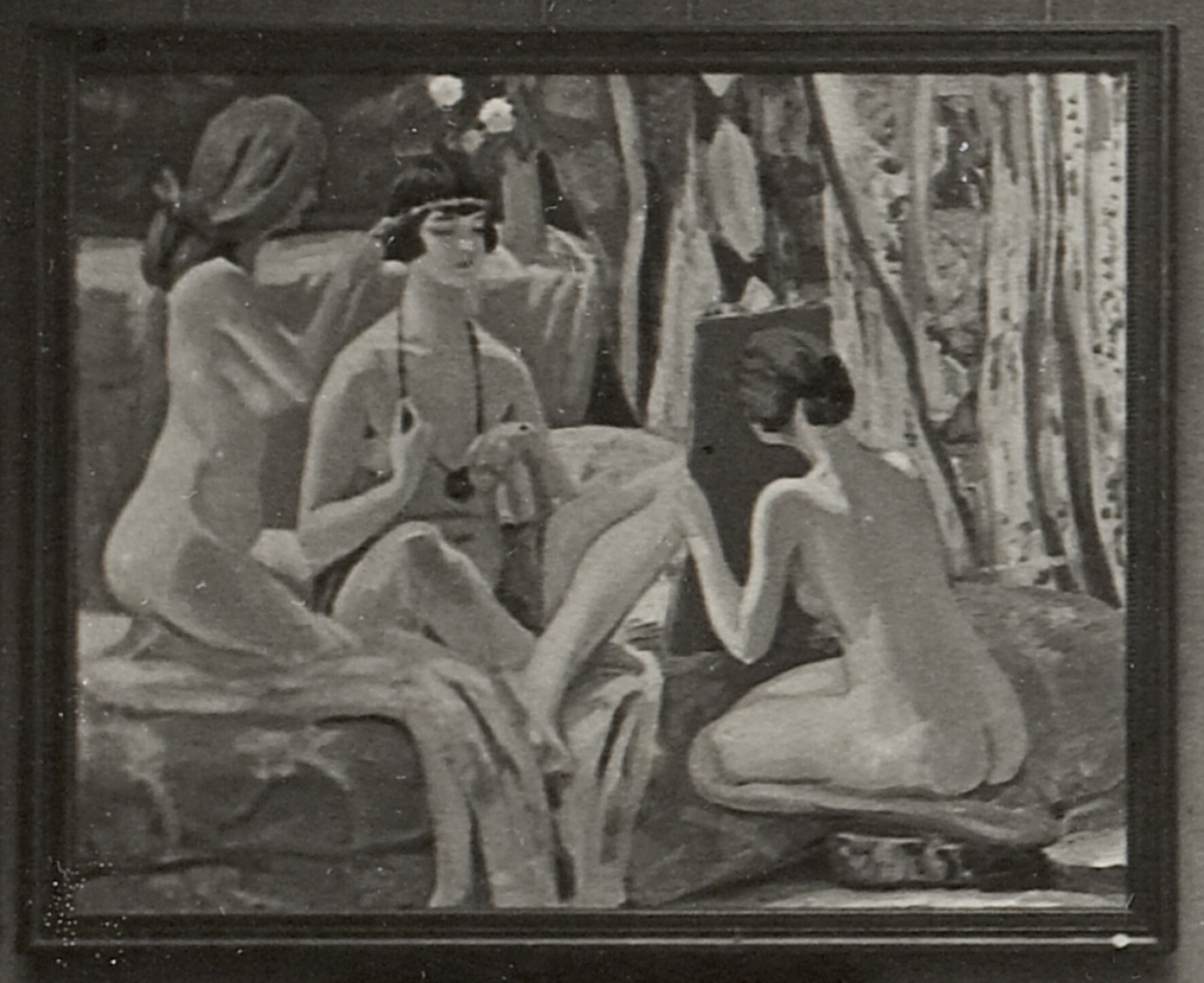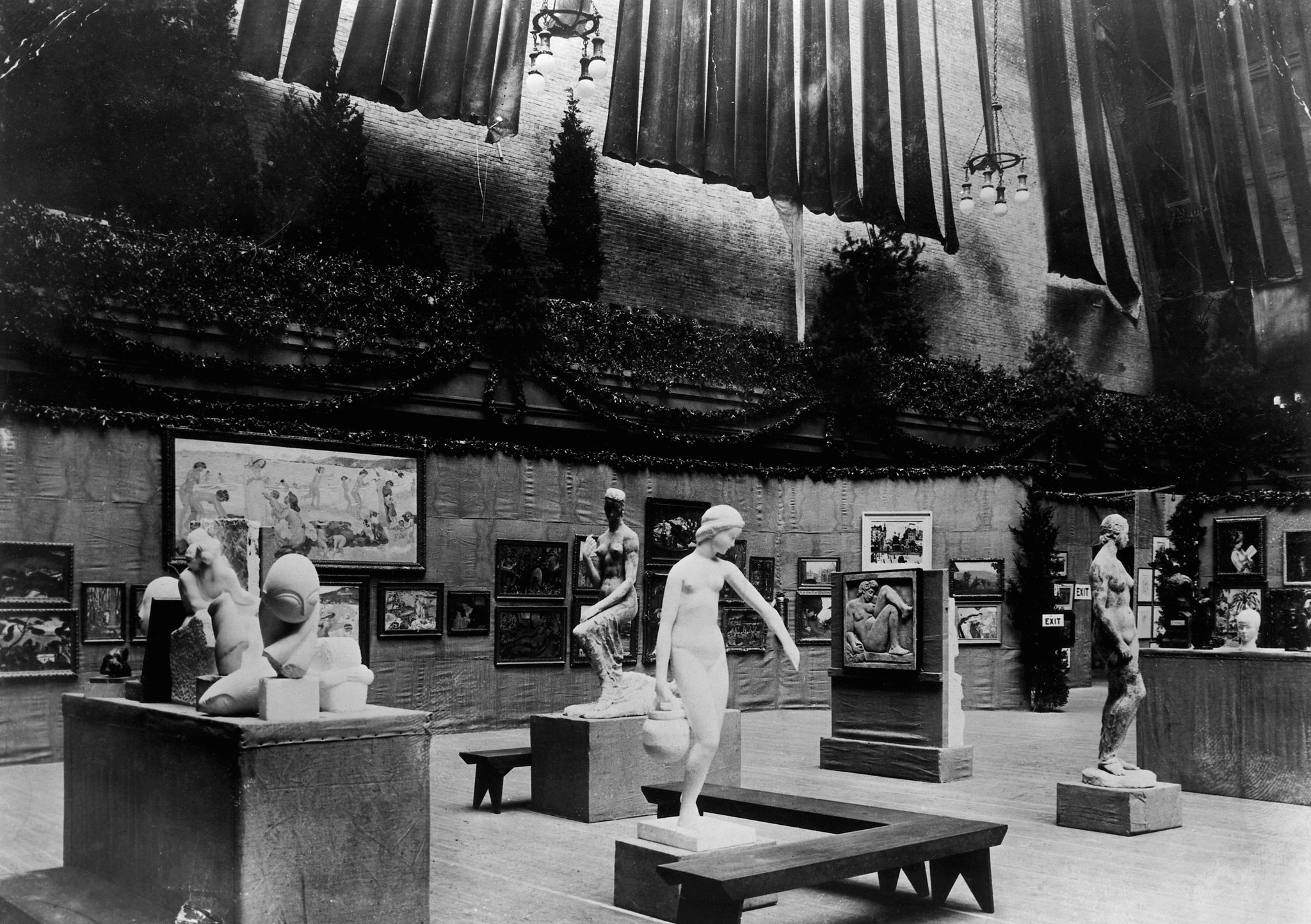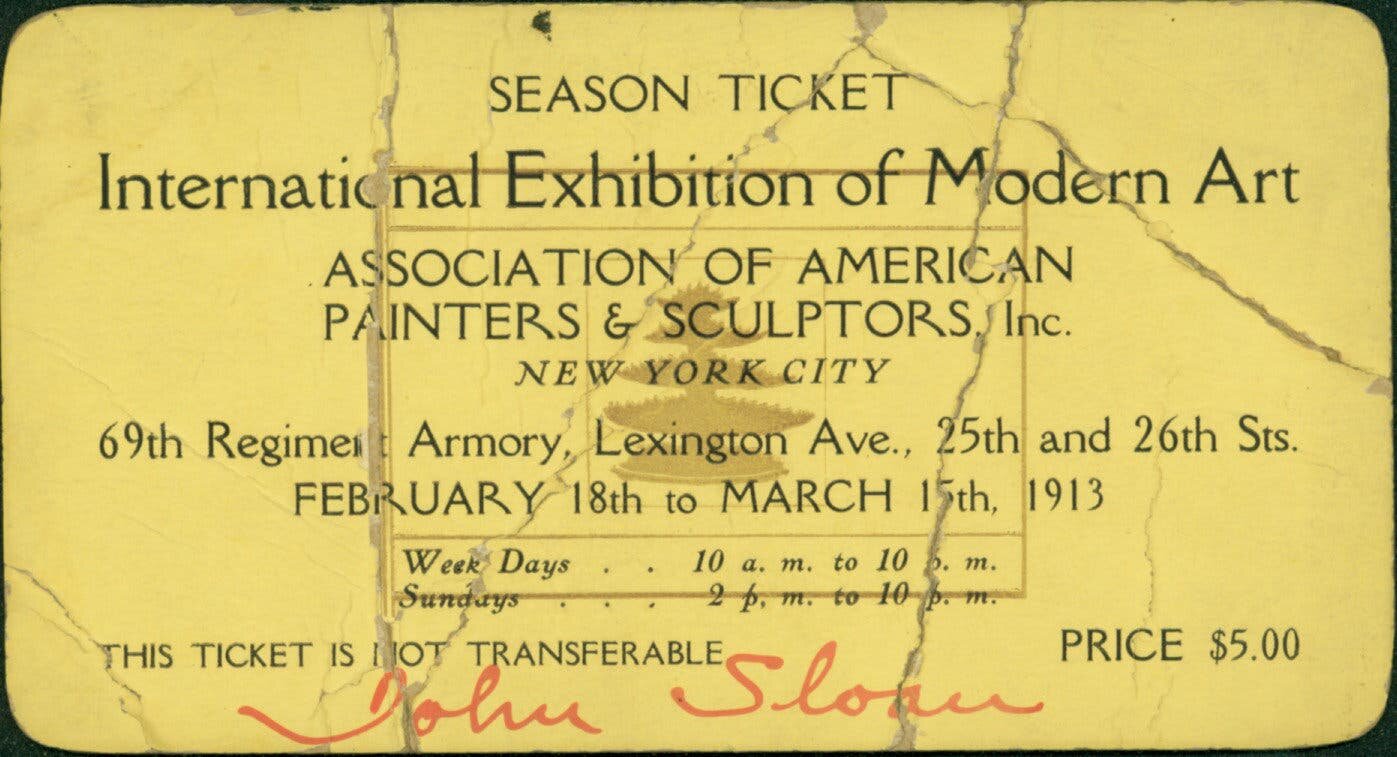Jacqueline Marval
1866 - 1932
“ONE OF THE MOST REMARKABLE ARTISTS OF OUR TIME.”
Guillaume Apollinaire,
L’INTRANSIGEANT,
25 février 1912
1866, Marie-Joséphine Vallet
Jacqueline Marval was Born in Quaix, near Grenoble, France. Her parents named her Marie-Joséphine Vallet, with which she will compose later her surname, Marval. Second child of a family of institutors, Marval studies, without real conviction, in order to become a teacher herself. She gets married, but losing her six months old child will be the major turning point of her existence.
Jacqueline Marval doesn’t want of her marital life anymore. She leaves her husband and therefore, must live and provide for herself.
Her creativity, as well as her confidence, allow her to acquire a certain reputation as a vest-maker and embroiderer. Marval lives from it, first in Grenoble, and then in Paris, providing for herself.
A few of her friends tell the story of how she would use her bed sheets as canvases when she no longer had any.
1895, her arrival in Paris
Jacqueline Marval leaves her native countryside for Paris, settling in the neighborhood of Montparnasse (9 rue Campagne-Première), which will become the heart of the artistic scene. She meets the painter Jules Flandrin (1871 - 1947, with whom she’ll live a thirty years love story), as well as Matisse, Van Dongen, Marquet, Picasso, Manguin, Camoin… Lots of them, impressed by her strong character and her outstanding personality, will become her friends. Jacqueline Marval starts painting spontaneously. Lively, she brushes out landscapes on cigar-box lids to show her friends, Gustave Moreau’s atelier students (including Marquet, Matisse and Flandrin), a direct painting, without any embellishment.
“FED UP WITH HEARING ABOUT THE CLAIMS AND PRETENSIONS OF MOREAU’S STUDENTS, SHE DASHED OFF A COUPLE OF LANDSCAPES ON CIGAR-BOX LIDS, ‘just to teach flandrin how it should be done’”
Hilary Spurling, The Unknown Matisse, 1998
Marval à vingt ans (Marval at 20 years old), photograph, 1886
Crane Kalman Archives, London
Jules Flandrin, Portrait de Jacqueline Marval, oil on panel,
45 cm x 30,8 cm, 1907
©Ville de Grenoble / Musée de Grenoble-J.L. Lacroix
Costumed bal at Kees Van Dongen’s, ca 1914
Costumed bal at Kees Van Dongen’s, ca 1914 (detail)
1901, first encounter
Marval’s first participation at the Salon des Indépendants (Paris) marks the beginning of her career as a painter. Ambroise Vollard buys ten paintings from her, including Odalisque au Guépard (1900), her nude self-portrait (perhaps the very first feminine nude self portrait of art history?). The famous art dealer will buy and sell Jacqueline Marval’s works for about ten years, succeeded by Eugène Druet and Berthe Weill.
Jacqueline Marval, Odalisque au Guépard, 1900 ( 110 cm x 220 cm)
Former Collection Ambroise Vollard
Former Collection Prince de Polignac
Former Collection Oscar Ghez, Musée du Petit-Palais, Geneva
Collection Comité Jacqueline Marval
1902, At Berthe Weill’s
Jacqueline Marval and her friends Henri Matisse, Albert Marquet and her companion Jules Flandrin show their work for the first time in a gallery at Berthe Weill’s, unique female galerist at the beginning of the century. In those days, she was, with Ambroise Vollard, one of the only galleries that would show young contemporary artists. The beginning of the 1900s is very successful for Jacqueline Marval, whom starts an important pictural activity that will be punctuated by many exhibitions, in Paris (Galerie Druet, Salon des Indépendants, Salon d’Automne), but also in Europe (Cercle de l’Art Moderne, Grafton Galleries London, Palais Youssoupoff, Gand, Galerie Crès Zurich, Prague French Art Exhibition), U.S.A. (Armory Show, Metropolitan Museum, Pittsburgh, San Francisco), or in Asia (Tokyo National Museum, Ohara Museum).
Invitation to the exhibition of the Berthe Weill Gallery, feb.1902
© Comité Jacqueline Marval
“I might surprise some of the indépendants visitors while affirming that Madame marval, whom remembers manet, is not lacking qualities. (…) Mrs Marval has nobleness and a very personal style”
Élie Faure, L’Aurore, 1er avril 1903
1903, Les Odalisques
It is at the Salon des Indépendants in 1903 that Jacqueline Marval shows her masterpiece, Les Odalisques (1902-1903), today at the Musée de Grenoble.
Marval is highly remarked when she shows this big avant-gardiste painting, which is quite particular: by its subject - a brothel scene - but also as the painter of this scene is a women, who had the audacity to paint herself as a prostitute five times on this canvas, which will notice her peers.
Amongst them, Apollinaire, Matisse, Elie Faure, see and acknowledge the painting that will become representative of Jacqueline Marval.
Comœdia, February 24th 1912
Jacqueline Marval, Les Odalisques (1902-1903), 200 cm x 220 cm
© Ville de Grenoble / Musée de Grenoble-J.L. Lacroix
Pierre Bonnard, Eugène Druet, 1912
1903, The Galerie Druet
When Jacqueline Marval meets Eugène Druet, thanks to Albert Marquet after he introduced him Matisse, little does she know how important this encounter will be in her career.
Druet, who opens his gallery at the very beginning of the XXth century on Rodin’s advices, quickly decides to show painters, still on the sculptor’s counselling: “there is a window: I will show you a whole group of promising artists” (Auguste Rodin).
Druet showed Marval for about 50 exhibitions, whether group ones (amongst Cézanne, Van Gogh, Marquet, Picasso, Manguin…) or by herself, such as the Jacqueline Marval exhibition of 1912, where more than 40 of her paintings are showed, some belonging to Ambroise Vollard.
If Jacqueline Marval was exhibited as much as she produced, for her 30 years career, one can’t deny the role that Eugène Druet, her friend, played in her recognition.
1913, New-York City, the Armory Show
1913 marks the first exhibition of Jacqueline Marval in the United States, where she will come back in the following years for diverse occasions (Metropolitan exhibition of 1919 (NYC), Pittsburgh in 1925, 1926, 1929 & 1930, San Francisco for the World Exhibition in 1915, Saint-Louis in 1916, etc).
Invited to participate by Ambroise Vollard, who helps with the creation of the event, Jacqueline Marval shows at the Armory Show (International Exhibition of Modern Art), L’Odalisque au Miroir (1911, a painting that is often mistaken by Les Odalisques, her 1902-03 masterpiece).
Her presence at this Salon places her in the spotlights of the European modern art scene, and gives her a certain importance. Painter and writer Arthur Hoeber qualifies the event as a “most inspiring” (Globe, March 9th 1913). Truly an avant-garde exhibition, the Armory Show proves that Modernity comes from Europe: it’s the first time Cubism painters are showed in the United States, the first time Americans discover, in their country, the movements that define modern art.
“it is not amusing, but appaling and disgusting. I was attributed saying that the human race was approaching madness. I never did, but if one tries ot convince me that this is modern art and this is representative of our present, I will have to think it is"
(ABOUT THE armory show)
Kenyon Cox, Harper’s Weekly, 1913
Théâtre des Champs-Élysées, Paris.
1913, Paris, the Théâtre des Champs-Élysées
In 1913, Jacqueline Marval is asked to take part in the big architectural project that the Théâtre des Champs-Élysées is.
This historical edifice, considered as one of the first Art Déco ones, is the first concrete building of the architects Auguste and Gustave Perret. The choice of this material puts the Théâtre des Champs-Élysées as an avant-garde building, way before others would start using concrete as well, such as Le Corbusier.
Sourrounded by Bourdelle, Maurice Denis, Vuillard and Ker-Xavier Roussel, Jacqueline Marval is in charge of the realisation of eight panels that will be the decor of the Foyer de la Danse. These panels represent different scenes of the ballet russe Daphnis et Chloé, obviously a reference to danse, but also to some elder men who could try and spend too much time in this Foyer de la Danse, where young dancers rehearse everyday.
This decorative order confirms the importance of Jacqueline Marval’s role in modern art, and on the French artistic scene in a larger sense.
Daphnis et Chloé, 1913.
Oil on panel, 110 cm x 115 cm. Théâtre des Champs-Élysées, Paris.
“since some elderly men who think money gives them rights and merits, come here as conquerors, those walls will let them know that nature only likes pairing youth with youth”
(about Jacqueline Marval’s panels at the théâtre des champs-élysées)
PAUL JAMOT, LA GAZETTE DES BEAUX-ARTS, FIRST SEMESTER 1913
Biarritz, ca 1923
© Comité Jacqueline Marval
1920s, Biarritz
In the 1920s, Jacqueline Marval is already an established Artist. With Flandrin, and with her friends such as the Couturier Paul Poiret, she discovers Biarritz, where she spends a lot of time. Back then, Biarritz becomes one of the main sources of inspiration of Jacqueline Marval. We owe her different stays there her beaches, baigneuses and fishermen, but also her paintings Jardin de ma Voisine (1923) and Jardin de mon Voisin (1923).
More than simple bathing scenes, these works are representative of a time - the beginning of the beach as a hobby, the changes regarding the costume and each one’s way of appropriation, whether it starts to look like what we know as a bathing suit, the perception of the body evolving with society.
Marval goes from painting the classical nude to painting the bather, typical of a society moving towards holidays in France.
Jacqueline Marval, Plage Rose, la Côte des Basques, c 1923.
Oil on canvas, 96 cm x 146 cm. Private collection, France.
All along her life, Jacqueline Marval will show at the occasion of Parisian Salons where her works (and herself) will be greatly remarked. If her outstanding personality makes her a one of a kind, it is thank to her talent that Marval has a voice and influence.
She will even be asked to produce the posters, illustrate the invitation cards and the catalogue covers for Parisian salons: Salon d’Automne, Bal de l’Amicale aux Artistes…
“TWO ARTISTS REQUIRE OUR ATTENTION, WHOM WILL STAY THE ONLY GREAT REPRESENTATIVE OF FEMININE ART AT THE BEGINNING OF THE XXTH CENTURY”
(ABOUT Marval et Laurencin)
André Salmon, La Jeune Peinture Française, 1912
Jacqueline Marval in front of her Kiki de Montparnasse portrait,
19 quai Saint-Michel, Paris, ca 1925
Salon d’Automne poster, 1923
Cover of the Salon d’Automne Catalogue, 1923
4 A bal poster, 1927
At the very end of the 1920s, after she was praised and very successful during all her career as a painter, Jacqueline Marval ignores the disease that starts to get to her. Her friend, the Art critic René-Jean puts her in emergency at the Hôpital Bichât (Paris). Jacqueline Marval dies at the end of May 1932.
Her passing will be told in all French press. Her works are nowadays in many private and public collections, mainly in France but also abroad.
Since 1932, year of her death, and at the exception of a few privates ones in galleries (Crane Kalman, Les Aristoloches, Galerie Thomire), only one retrospective exhibition of her work took place, at the Musée Hébert in 1987.
“MARQUET and MATISSE were bowled over by admiration for Marval’s personality, as much as for her work”
Hilary Spurling, The Unknown Matisse, 1998
Jacqueline Marval wearing Paul Poiret, Hendaye Beach, circa 1923








